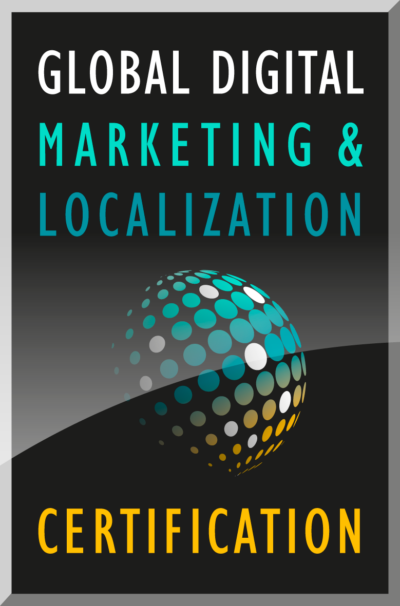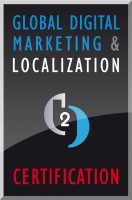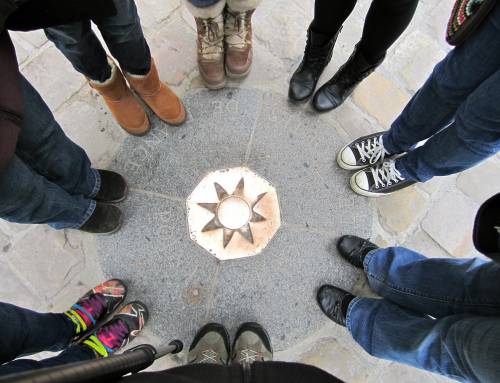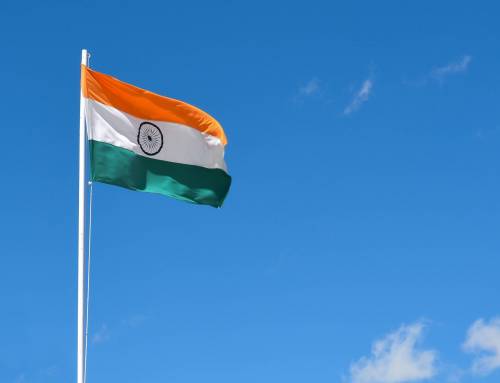This is the final paper presented by Chinedu Mkpuluma, a recent graduate of the Global Digital Marketing and Localization Certification (GDMLC) program. This paper presents the work being produced by students of The Localization Institute’s Global Digital Marketing and Localization Certificate program. The contents of this Paper are presented to create discussion in the global marketing industry on this topic; the contents of this paper are not to be considered an adopted standard of any kind. This does not represent the official position of Brand2Global Conference, The Localization Institute, or the author’s organization.
Introduction
Globalization and localization refer to a company’s efforts to reach, establish, and cement relationships between their customers and their company or brand. These outreach activities can make the difference between success and failure in target markets. They help give companies attempting to build their business in specific regions a sense of the area’s culture, segmentation, and market forces. Efforts to globalize and localize a brand or company also factor in consumer/network behaviors, and whether corporate acquisitions have expanded the company’s global footprint.
This document examines Ciena’s foray into globalization and localization efforts. Ciena is undergoing a corporate evolution marked by both its work toward globalization and its transformation of network arrangements and bandwidth consumption in the market today.
Literature review
Across industries and sectors, global marketing leaders are under increasing pressure to balance their choices regarding positioning and strengthening corporate brands. Globalization and localization address these needs, but many companies seem to still ignore globalization and localization efforts on the Web, focusing more on macro- and micro-economic factors. With the continued promise of the growth of digital assets and the Internet, companies can use this avenue to target foreign markets and regions easily and effectively.
According to a McKinsey report by Manyika et al. (2016), globalization has stalled. But, although the global goods trade has flattened and cross-border capital flows have declined sharply since 2008, globalization is not heading into reverse. Rather, it is entering a new phase defined by soaring flows of data and information. Also, digital information flows—which were practically nonexistent just 15 years ago—now exert a larger impact on GDP growth than the centuries-old trade in goods.
According to Singh et al (2005), a country- and industry-wide analysis of the Web pages of 870 U.S. and international companies shows that website globalization is still at a nascent stage, with almost 57 percent of company websites surveyed showing low levels of website globalization. Countries such as Switzerland, the Netherlands, Sweden, and the U.S. showed higher levels of website globalization.
Among the industries, consumer software, electronics, entertainment, and consumer durables showed the highest levels of website globalization.
It is possible that executives and shareholders in the four countries mentioned above, which were revealed to have the highest rate of international outreach, expect increased revenues from global operations and use globalization and localization as an important piece of their marketing outlay. According to Manyika et al., some 900 million people have made international connections on social media since 2005, and 360 million take part in cross-border e-commerce, with the potential of reaching into fast-growing markets. To effectively target foreign Internet shoppers, companies must tailor their websites for different regions (Lynch et al., 2001[1]) to reach the four billion people who speak languages other than English.
What prompted the need to Globalize and Localize?
Ciena was prompted to globalize and localize after acquiring another telecommunications company’s core business arm, with a global footprint. Prior to this purchase, Ciena’s acquisitions were telecommunications and network companies with core markets in North America. Ciena is now working to further penetrate its existing customer base and broaden its addressable market to include emerging markets and new customer geographies, locales, and segments. The acquisition that expanded Ciena’s global footprint has also shifted the company’s overall corporate goals and objectives and necessitated translations to target languages in the business’ newly tapped locales.
Ciena’s Globalization and Localization Efforts
This paper will outline Ciena’s globalization and localization efforts in a provisory and preliminary nature due to business evolutions from acquisitions made, market shifts in the telecommunications industry from severe downturns in the early 2000s, growth and innovation from emerging markets, and transformational transactions made outside of Ciena’s core competence in the networking industry. Globalization and localization from Ciena’s current perspective can be characterized by:
- The expansion of Ciena’s dot.com site to cut across regions, thereby catering specifically to the needs of particular markets in the regions and adhering to privacy legislation across geographies
- Wanting to cater to the somewhat increasing similarities in appetite for bandwidth and network consumption in a very fast-growing, web-scale world
- The diminution of geography with technology (smart and intelligent networks, packets, switches, routers, hubs), helping to break the tyranny of physical boundaries and borders
- The slight weakening of nation-states with the rise of the new global market and the development of commercial instead of political blocs
Ciena’s Globalization and Localization Timeline and Evolution
2004 – Brand repositioning and refreshed website
2010 – Acquisition of Nortel’s Metro Ethernet Networks Business (largest acquisition in Ciena’s history gave Ciena a global footprint overnight, prompting the need to globalize and localize websites[2]
2011 – Globalization and localization of sites for regions began (website created in 13 languages based on the regions served)
2013 – Divided websites to Big 7 and Small 4, which killed certain English-dominant sites
2014 – Started global and localized PPC campaigns
2015 to present – Seven fully translated and localized websites with steady traffic growth (more than 18 percent of traffic is global), delivering geo-targeted content based on country/locale user behavior and active PPC campaigns, driving higher-value traffic where leads engage, register, download, and click within the site
Ciena’s Globalization and Localization Challenges
The challenges Ciena faces in its global outreach differ to some extent based on the size and the reach of the seven current sites, cultural barriers and language differences, and the company’s depth of understanding of local content needs and how to deliver the content appropriately. For Ciena, the concerns of language and cultural context to meet the locales’ needs came relatively late in the company’s outreach journey. Content, resources, and technology were the areas in which Ciena faced its greatest obstacles.
- Content – The company had very little translated content and structure for globalized and localized sites. It created 13 new translated sites, of which six were originally global pamphlet sites, without a lot of deep content to be globalized and localized. Also, at the onset, there was very little input from the locales and regions on what was current and relevant in those areas, which presented questions about where to focus translation and transcreation efforts.
- Resources – At the onset of its globalization and localization tasks, Ciena had the equivalent of three full-time employees devoted to the task: a Web content specialist, a translation manager, a half-time developer, and a half-time Web manager. There was also the dilemma of how to leverage the local resources available for content adaptation to better serve locales and regional-specific campaigns, as well as the technical and organizational infrastructure to be put in place for the globalization and localization journey to adapt and evolve in the ever-changing digital space.
- Technology – The Digital Marketing Team had to look for a new Content Management System (CMS) to support multi-domains, internationalization (handling of multiple languages and cultural conventions without a lot of redesigns), and Web content globalization and localization efforts, as the old CMS was very cumbersome. Features in the CMS had to be fine-tuned and enhanced along the way to accommodate the globalization and localization of content. Most technology vendors are still working and fine-tuning the globalization and localization pieces in their systems to accommodate client needs.
- Goals setting – with little to no experience on globalization and localization at the onset, setting starting points and achievable globalization and localization KPIs were a bit of a challenge.
Summary
Because the world is so interconnected, globalization and localization are now helping brands, companies, and content move beyond the confines of geography. Commerce, content creation and usage, product development and use, and bandwidth consumption no longer feel distant. Globalization and localization have brought about a paradigm shift in the way business is done and content is consumed, with physical borders and boundaries becoming increasingly irrelevant.
Companies and brands are refining their cultural outreach as they cater to their business locales. Running region-specific campaigns is further helping brands and companies learn what to offer these locales to create a better and lasting consumer and end-user experience. Globalization and localization are the price that must to be paid for brands and companies to be able to perform on a global scale.
References
Definition – Globalization has a slightly different meaning in the localization industry and in general business. In the localization industry, it is seen more in terms of overall process terms; from the general business perspective, it has broader micro- and macro-economic market implications.
Manyika, J., Lund, S., Bughin, J., Woetzel, J., Stamenov, K., and Dhingra, D. 2016. Digital globalization: The new era of global flows. A McKinsey Global Institute Report. http://www.mckinsey.com/business-functions/mckinsey-digital/our-insights/digital-globalization-the-new-era-of-global-flows?cid=other-eml-alt-mgi-mck-oth-1602
Singh, N. & Boughton, P.D. 2005. Measuring Website Globalization: A Cross-Sectional Country and Industry Level Analysis. Journal of Website Promotion. Volume 1, Issue 3, 2005, pages 3-20.
Lynch, Patrick D., Robert J. Kent, & Srini S. Srinivasan. 2001. The Global Internet Shopper: Evidence from Shopping Tasks in Twelve Countries. Journal of Advertising Research, 41 (May/June): 15-23.
Acquisition History – http://media.ciena.com/documents/Ciena+acquisition+history+chart.pdf
Argentina: http://www.cienaargentina.com.ar/ | Brazil: http://www.ciena.com.br/ | France: http://www.ciena.fr/ | Germany: http://www.ciena.de/ | Italy: http://www.ciena.it/ | Japan: http://www.cienacorp.jp/ | Korea: http://www.ciena.kr/ | Mexico: http://www.ciena.com.mx/ | Netherlands: http://www.ciena.nl/ | Poland: http://www.ciena.pl/ | Russia: http://www.ciena.ru/ | Spain: http://www.ciena.es/
Copyright © 2016 The Localization Institute. All rights reserved. This document and translations of it may be copied and furnished to others, and derivative works that comment on or otherwise explain it or assist in its implementation may be prepared, copied, published, and distributed, in whole or in part, without restriction of any kind, provided that the above copyright notice and this section are included on all such copies and derivative works. However, this document itself may not be modified in any way, including by removing the copyright notice or references to The Localization Institute, without the permission of the copyright owners. This document and the information contained herein is provided on an “AS IS” basis and THE LOCALIZATION INSTITUTE DISCLAIMS ALL WARRANTIES, EXPRESS OR IMPLIED, INCLUDING BUT NOT LIMITED TO ANY WARRANTY THAT THE USE OF THE INFORMATION HEREIN WILL NOT INFRINGE ANY OWNERSHIP RIGHTS OR ANY IMPLIED WARRANTIES OF MERCHANTABILITY OR FITNESS FOR A PARTICULAR PURPOSE.
Author Bio:
Chinedu Mkpuluma
Analyst, Digital Marketing at Ciena
Chinedu Mkpuluma works in Digital Marketing for Ciena’s Global Marketing team where he works on different marketing programs and campaigns that focus on content strategy/development/
Download this Paper: CLICK HERE











